Sigma 70-200 mm f/2.8 EX DG APO OS HSM
3. Build quality and image stabilization
When Sigma started to equip its lenses with image stabilization it was pretty clear that one of the first models where such a mechanism should be implemented was the journalistic 70-200 mm f/2.8. That’s why two years after the launch of the Sigma 70-200 mm f/2.8 II EX APO DG MACRO HSM we saw the announcement of the Sigma 70-200 mm f/2.8 EX DG APO OS HSM, which is tested here. Compared to its predecessor the number of elements in the new device increased significantly; it resulted in the increase of weight and, of course, adding the optical image stabilization OS. The Macro nickname disappeared for a change because the minimum focus distance increased from 1 meter to no less than 1.4 meters. It is a noticeable backwards move especially that the competitors actually decreased that distance in their new models (Canon to 1.2 meters and Tamron to even 0.95 of a meter).
Let’s have a glance at the comparison between the new Sigma, other stabilized rival lenses and a not stabilized Tamron, which is presented in the next chart. The Tamron is physically the lightest and the shortest but you must keep in mind the fact that it is not stabilized and it doesn’t feature an ultrasonic autofocus motor. From the remaining three devices exactly the Sigma is the smallest and the lightest.
Please Support UsIf you enjoy our reviews and articles, and you want us to continue our work please, support our website by donating through PayPal. The funds are going to be used for paying our editorial team, renting servers, and equipping our testing studio; only that way we will be able to continue providing you interesting content for free. |
- - - - - - - - - - - - - - - - - - - - - - - - - - - - - - - - - - - - - - - - - - - - - - - -
The photo below shows the tested lens positioned between two Canons 70-200 mm f/2.8, an older model without stabilization (on the right) and the newest model launched not so long ago (on the left)
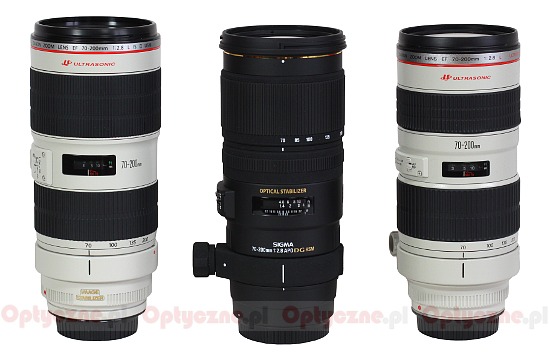 |
The Sigma 70-200 mm f/2.8 EX DG APO OS HSM, like all lenses of this producer, starts with a metal bayonet mount equipped with contacts. In it we find the rear element, 35 mm in diameter, hidden about 2 centimeters inside. The element remains motionless during focusing and zooming as well.
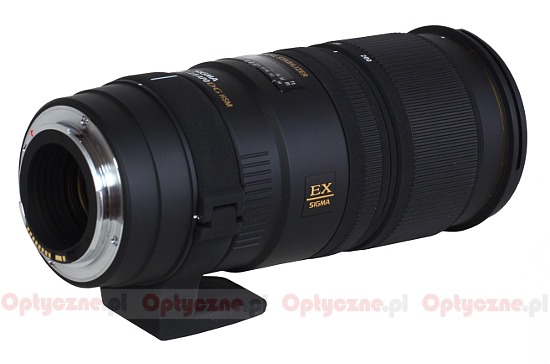 |
Behind the mount there is a fragment of the barrel made of smooth metal and then a tripod adapter. After that we see another fragment of smooth barrel with the inscription, featuring the name and the parameters of the lens. Further on, we find a clear distance scale behind a window, expressed in feet and meters. Immediately below it there are depth of field markings for the minimum and the maximum focal length (W – for wide and T – for tele). For T we get f/22 markings only and for W – f/22. f/16, f/11 and f/5.6. On the left from the distance scale we encounter the focus mechanism mode switch (AF/MF), the stabilization control as well as its mode switch (OFF, 1,2). Opposite to the distance scale there is a serial number of the lens and the information that it was made in Japan.
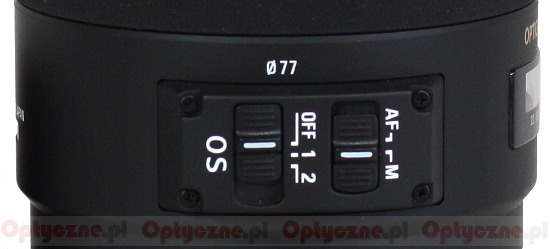 |
Moving on we see a manual focus ring. For this type of equipment it is not wide because only 22 mm and the ribbing takes just 10 mm. Touching the lens for the first time I feared whether you could operate it comfortably and precisely. A longer test made my doubts disappear. The ring moves smoothly and is well-damped, allowing very precise settings.
The next ring changes the focal length. It is 46 mm wide for a change and its work is good. Moving it from 70 to 200 mm the ring works smoothly and is well-damped in the whole range. Going backwards you can feel a bit higher resistance in the range from 100 to 70 mm.
After the zoom ring we can find the next fragment of the smooth barrel with a golden strip which signifies the highest EX Sigma series.
The front element, being almost 7 cm in diameter, is immobile and surrounded by a non-rotating filter thread with a diameter of 77 mm. Because of that the Sigma 70-200 mm OS will cooperate with all kinds of filters without any problems.
In terms of optical construction the Sigma has a lot to boast of. This class of equipment features simply everything the best a given producer can offer and the Sigma is not an exception to this rule. The lens consists of as many as 22 elements in 17 groups. The front system of four huge elements includes no less than two FLD (F Low Dispersion) glass elements which optical properties are supposed to be similar to those of precious fluorite. Additionally, you can find one more SLD (Special Low Dispersion) element between them. The following two SLD elements are positioned in the rear part of the lens. Inside the whole construction there is also a circular aperture with nine diaphragm blades which can be closed down to f/22.

The producer informs us that they used high quality anti-reflection Super Multi-Layer Coatings, guaranteeing high transmission level and very good work against bright light.
The buyer gets both caps, a tripod adapter, a very high lens hood and a hard case included in box. As it is already the EX series standard, the lens comes with a 3-year-long warranty period with the optional extending it at a charge by two following years.
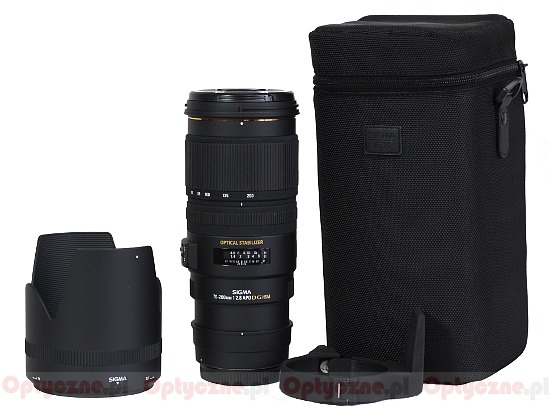 |
Image stabilization
The Sigma claims that its optical stabilization module is as efficient as 4 EV. Of course we decided to check it. To do so, we shot several dozen photos at 200 mm focal length for every exposure time in the range from 1/250 to 1/5 of a second with the stabilization on and off. Then, for every time we determined the percentage of blurred photos. It is presented on the graph below, in correlation with the exposure time expressed in EV where the point of 0 EV is the equivalent of 1/200 of a second.
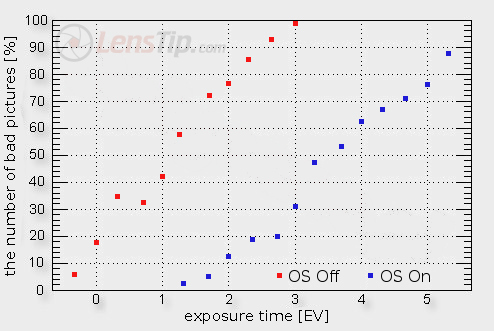
As you see we don’t get to those declared 4 EV because the maximum distance between both curves reaches 3 EV, momentarily a tad more. 3 EV is still a good result so there are no reasons to complain. It’s worth noticing, though, that the rival Nikkor 70-200 mm VR II had the result at the level of 3.7 EV in analogous test so it fared a bit better than the Sigma.






